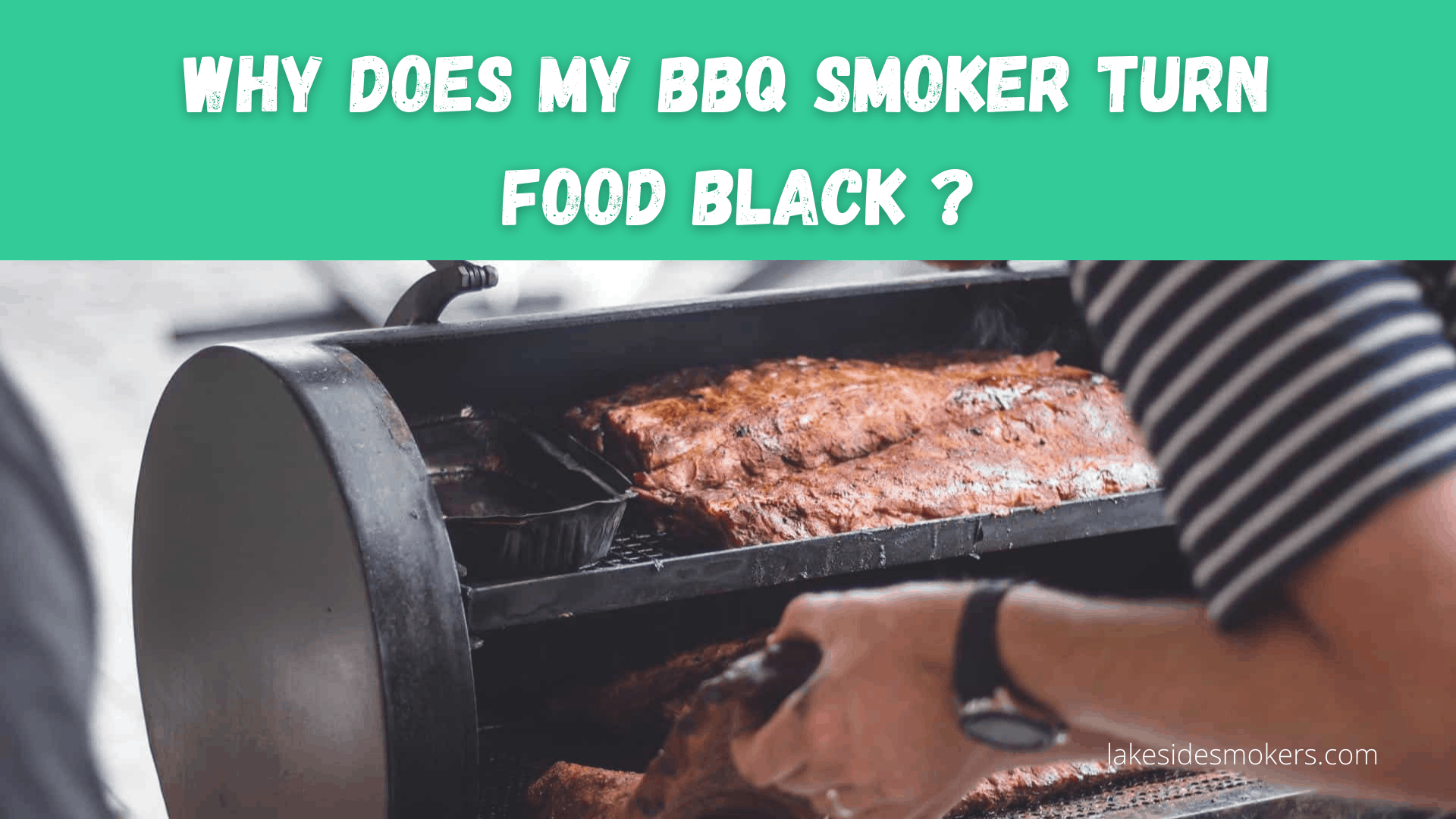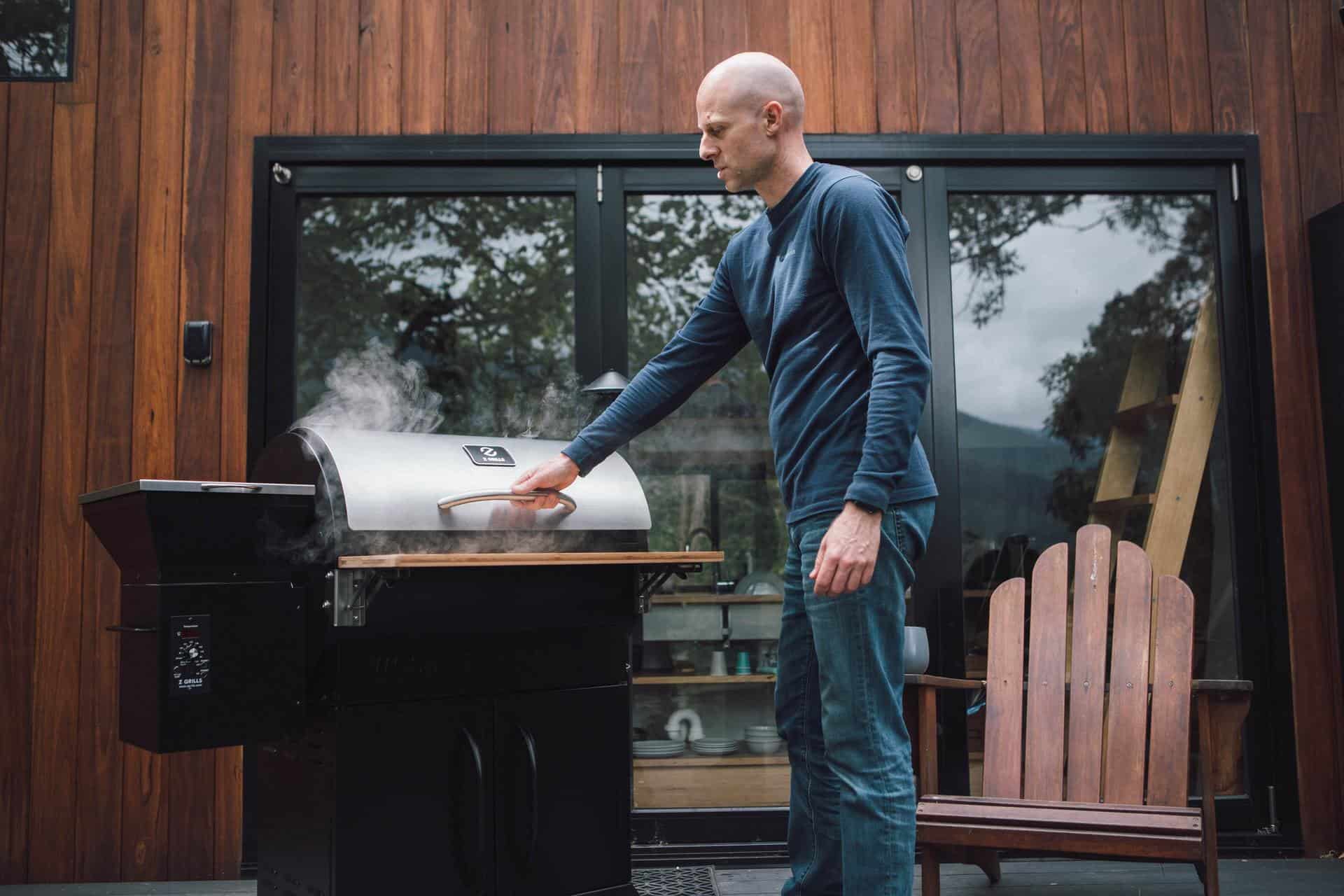There’s nothing worse than spending hours smoking meat low and slow only to end up with blackened food.
It is very unappetizing and I’m sure you’re worried it could be dangerous too. I know it’s not tasty at all.
But there are many potential causes and I’ll list the most common reasons why the smoker is making food black, plus how to solve the issues.

There’s no need to replace your smoker, but if your meat turns black in the smoker, it’s usually one of two reasons.
The black residue, called creosote is caused by oil and grease buildup in the smoker. This means the smoker needs a deep clean. Alternatively, it could just be a lack of proper ventilation which is common with pellet and gas smokers. Luckily, all of these potential causes are fixable.
In this article, I’m sharing everything you need to know about the bitter black soot on your food and how to avoid it while cooking with your smoker.
In this post we'll cover:
What causes my meat to turn black in the smoker?
It looks like black soot on your brisket. So, what is it? Is it a dangerous substance? Can it make you ill?
These are all valid questions!
There are several reasons why the smoker is turning food black. Let’s take a look at some of the most common issues. Then, for each problem, I am sharing a plausible solution so you can keep smoking with peace of mind.
But the bottom line is that the black stuff is unhealthy and needs to be avoided.
The likely culprit: creosote
At first sight, it would seem that smoke causes the black stuff on your meat. But, it’s actually called creosote.
It forms in wood-fueled smokers. This is one of the most common reasons why the smoker makes the meat black.
Creosote refers to the black, oily substance that is leftover in the smoker after cooking at very high temperatures for a long time.
“Creosote is a category of carbonaceous chemicals formed by the distillation of various tars and pyrolysis of plant-derived material, such as wood or fossil fuel.” (Wikipedia)
The creosote is a result of incorrect combustion of the wood inside your smoker. It gets into the smoke and builds up on everything.
So basically, if your smoke is too heavy, dense, and dark, it causes a creosote build-up.
Unfortunately, this creosote covers the surfaces of your smoker on the inside. Then, it also covers your meat and other foods and changes the color to black.
What’s even worse, it also alters the taste of the food and makes it bitter, and gives it an awful aftertaste. In some cases, lots of creosote makes your mouth and tongue feel tingly, numb, and uncomfortable.
What causes the creosote build-up?
- there is too much fuel inside the smoker
- your coals are burning too fast
- you aren’t controlling the temperature well enough
- there isn’t enough airflow inside the unit
- the coals are smoking but not hot enough
Why is it bad and is it dangerous?
The problem with the creosote is that it makes a delicious rib rack inedible. It ruins all your meat and discourages people from using their smoker.
Most of the time, the smoker is fine, it just needs some maintenance and you have to remove the creosote.
When your smoke is clear in color, there is no creosote, and it’s safe to eat. But, when it’s a dark color, it’s full of this dangerous substance.
Exposure to creosote can cause irritation in the eyes, nose, and airways. After prolonged exposure, it can cause cancer.
How to get rid of creosote
Most of the thick and oily creosote stays stuck on the grates or builds up on the sides of the smoker.
You need to do a proper clean to remove it.
- Use a propane torch or weed burner if you have one and start burning off the soot buildup in the smoker. You can use the torch to burn the creosote off from the grates and insides but be careful not to burn external components. The creosote turns into ash and it will come off from the metallic materials. Then, wipe with a cloth.
- If you don’t have a torch, you can use a hard wire brush or a scraper. Manually scrape and rub the affected areas until you remove the buildup. With a damp towel, remove any leftover creosote.
- If the creosote still doesn’t come off, you can use a bit of water and a towel to scrub it. Also, a bit of dish soap can do the trick but make sure to rinse well.
- Once you’ve removed the creosote you need to re-season the smoker with vegetable oil. This will help prevent more creosote buildup in the future.
Also read: Best BBQ smoker accessories (22 must-have smoking tools)
Another reason for blackened food: lack of ventilation

One of the most common reasons that your smoker turns food black is due to lack of ventilation.
If for some reason, the air cannot flow properly in your smoker, then the food turns black. The air must flow on all levels of your smoker or else residue builds up and creates lots of creosote.
Black soot is common in all types of smokers if the airflow is obstructed in any way.
So, it’s essential that you check that there is proper ventilation from all parts.
Clean vents and other components
The thing about ventilation is that it’s hard to tell when the vents aren’t functioning properly.
First, you have to try doing a deep clean for all the vents, dampers, tubes, grates, and any other remaining components. Don’t worry, you can take the smoker apart and then put it together again because it’s not very complicated.
First, examine the vents. Check the vent for any soot deposit and any blackness on the vent pieces. The vent controls airflow and if it’s clogged even a bit, it can make the food black.
When you find that it is blocked or there’s a lot of creosote on it, clean it well with a wire brush or some dish soap and water.
All the visible parts of the smoker must be cleaned thoroughly every few months, especially if you use the smoker regularly.
Don’t forget about the special tube that connects the smoker to the grease catcher, usually located on the outside. This tube can get clogged with oil and creosote.
If it has a blockage, you can take the tube off and clean it with a small pipe cleaner. It’s important that you dry it well before putting the tube back.
Learn here How to Clean Electric Smoker The Easy Way
Stale smoke in pellet smokers
Pellet smokers are susceptible to a phenomenon called stale smoke.
The key to tasty barbecue is to have live smoke that’s sweet and burns clean. To do this you need to maintain a constant temperature and airflow.
So, ventilation is the most important for pellet smokers. As I mentioned above, you must keep the vents clean and clog-free.
The smoker keeps pushing out the smoke constantly but if the smoke lingers inside the smoker, it becomes “stale smoke” and that’s bad news. It causes creosote formation on your meat and turns it black and bitter.
Thus, keep in mind that bad stale smoke equals sooty, bitter, and wasted meat.
Tube blockage in gas smokers
One of the causes of blackened meat can be a result of a blockage in your gas smoker’s venturi tubes. So, the black buildup is the first sign of a serious blockage that doesn’t let enough air and gas flow to the burners.
The only real solution to this problem is to clean the tubes and inspect burners to ensure proper air and gas flow.
How to clean the gas smoker
After the unfortunate event when your smoked food turns black, you have to clean the gas smoker.
First, wait for the smoker to cool down completely to avoid burns. Then, remove the burner and check the ports. You can tell that the ports are full of buildup because it’s visible to the naked eye.
Use a soft bristle brush to clean the ports. Also, you can remove debris with a paper clip by poking small holes.
Then, for the next part, clean the burner venturi tubes. You can use a pipe cleaner or special venturi brush if you have one (it looks like a pipe cleaner) and push the cleaner through the tube and turn to ensure all the gunk is removed.
When you remove the brush, look to see if there is any debris.
Usually, besides the dirty black soot, you might have spiders and webs living in the smoker. You can also add some spider guards to put in front of the air intake holes.
Sometimes there is also a buildup of grease that burns on the bottom of the smoker. Remove the cooking grates and grids and scrape the well with a stainless-steel barbecue grill cleaning brush.
Then, remove the remaining ash and debris from the smoker. You can also use a bit of water to clean really dirty parts.
After this type of thorough clean, the smoker should no longer turn your meat black.
Bottom line: your gas smoker needs a clean every once in a while
I’ve talked about cleaning the smoker quite a lot so far. But, many people forget to clean all the components.
If the smoker is making your food black, then the reason might be as simple as this: the smoker is dirty and you need to clean it. A dirty smoker creates bad smoke and bad-tasting food.
Air shutters located at the burner base must be cleaned regularly.
The thing is that if are full of soot and grease, they will no longer produce blue flames and they will produce yellow flames. This means that the burner is creating soot.
The air shutters are very important components of your gas/propane smoker. They regulate the mixture of air and gas that so the burner can produce a strong flame.
Don’t skip cleaning the cook box and the Flavorizer bars if you have them.
Your outdoor smoker is susceptible to all kinds of dirt and debris falling into it or spiders nesting there, even if it’s covered. But, to make sure it stays clean, use a smoker cover.
Charred meat
There’s a difference between the black sooty stuff on your meat after smoking and charred meat. Severely charred meat is a result of charred carbon in the grill.
Charring occurs when you overcook your food. Many people eat burnt barbecue and charred foods, but there are risks involved.
Is eating charred meat dangerous?
Sure, a small amount of charring lends that tasty smoky flavor, but a lot of it is dangerous for your health. According to the National Cancer Institute, charred BBQ can increase your risk of cancer.
When you grill for a longer time, chemicals like HCA and PAH form on the meat, and these are carcinogens.
Meats that are well-done and slightly burnt have a much higher concentration of HCA, which can damage human and animal DNA and cause cancer.
So, always avoid charring your food when grilling and smoking.
Takeaway
So, whether your fuel is wood pellets, charcoal, or gas, the smoker needs an occasional clean to ensure there is proper ventilation and airflow. Also, you have to remove the creosote caused by oil and grease buildup.
If you perform regular maintenance, your fresh cooked meat won’t taste bitter and it won’t be covered by that nasty black soot.
After all, who doesn’t love a good rotisserie chicken with crispy skin? The last thing you want is creosote that makes your mouth numb. That’s just a major waste of delicious food!
So, make sure to keep smokers and grills clean.
Read next: What to Do When Your Barbecue Smoker Has Too Much Smoke

